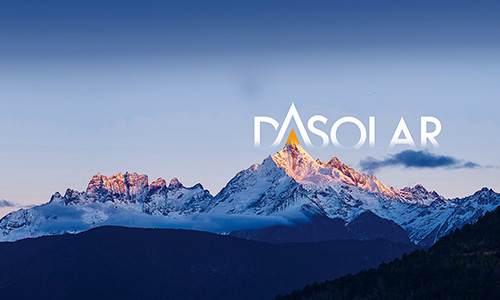From Farms to Hills: How DAS Solar Shapes a Sustainable Future with DAS ECO Solutions
2024-10-16
With the increasing urgency of global clean transition and carbon neutrality, the solar industry is exploring diversified development models. By combining solar power generation with agriculture, animal husbandry and complex terrains, DAS Solar is fostering innovative “PV+” applications in the name of DAS ECO solutions, creating models that achieve dual economic and ecological benefits. These complementary systems not only optimize land use but also significantly contribute to environmental restoration, creating a sustainable path for rural revitalization.
Agri-PV: A Boost for Green Agriculture
The agri-PV model effectively combines solar power generation with agricultural production, optimizing land use by enabling crops to grow beneath the solar modules. This model addresses the conflict between land for agriculture and land for renewable energy development, providing a sustainable path for the coexistence.
In the agri-PV model, solar modules act as natural shade structures, reducing ground temperatures and minimizing soil moisture evaporation. This creates a cooler environment for crops, improving their growth conditions and enhancing agricultural yields. By adjusting the solar arrays and incorporating reflective materials, sunlight is optimized for both crops and energy generation.
For example, in Shaanxi, China, a large-scale agri-PV project employs both the DAS Solar N-type 4.0 modules and the company’s flexible mounting systems. The modules are equipped with the latest generation TOPCon 4.0 Plus cells with a mass production efficiency of over 26.7% and an open-circuit voltage of 742mV, exhibiting excellent power generation performance. Meanwhile, the elevated pre-stressed flexible mounting system is cleverly positioned above apple orchards. With a single span of 33 meters and a design height of 5.5 meters, the layout ensures over 70% sunlight exposure for the apple trees, boosting both agricultural profits and energy production.
.png)
Agri-PV systems offer additional environmental benefits by reducing the use of chemical fertilizers and pesticides. By improving soil microclimates and reducing surface temperature, these systems enhance soil health and foster biodiversity, creating a harmonious coexistence between agriculture and nature. Agri-PV is already playing a significant role in transforming traditional agriculture into a more sustainable model.
Livestock-PV: Enhancing Pasturelands in Harmonious Coexistence
The core of the livestock-PV model is the concept of "solar above, livestock below," which optimizes the spatial layout of solar modules to support livestock grazing and pasture maintenance beneath. By elevating solar arrays, the system allows sunlight to be absorbed efficiently by the modules, while also creating shaded areas underneath, which are suitable for growing grass and grazing livestock. Adjustments in the tilt angle, height, and spacing of the modules ensure even sunlight distribution. This, combined with natural rainfall, microclimate regulation, and water filtration from solar module cleaning, creates ideal conditions for pasture growth, minimizing the need for artificial irrigation and fertilizers.
In regions with harsh climates, the shade provided by solar modules protects livestock from extreme weather conditions. The use of solar modules also helps reverse desertification and improve soil quality in desert regions. At the Kubuqi Desert in Inner Mongolia, solar modules are combined with livestock farming to promote grassland restoration and sand control. With a total capacity of 2GW, the project is estimated to generate approximately 4.1 billion kWh of electricity and reduce sediment flow into the Yellow River by 2 million tons annually. While the top layer of dual-glass modules maximizes solar energy capture, the space below is used to cultivate shade-tolerant crops like quality grasses and medicinal herbs. Meanwhile, the project adopts a livestock-crop coupling model for land rehabilitation, including chicken farming and sheep grazing. Livestock manure is then utilized to improve soil quality, aiding in increasing vegetation coverage and reducing soil erosion.
.png)
Additionally, the livestock-PV model creates a self-sustaining cycle where rich grass under the modules feeds the livestock, and their manure returns nutrients to the soil, enriching pasture growth. As a result, local farmers benefit from increased livestock productivity, while solar power plants provide a stable source of clean energy. This model not only generates economic benefits but also creates new employment opportunities in rural areas, helping residents increase their income and benefit from the sun.
Hill Projects: Harnessing Solar Power in Challenging Terrains
The expansion of solar energy projects into diverse environments has necessitated innovative solutions, particularly for regions with uneven or hilly terrains. Hill projects, where solar modules are installed on sloping or rugged landscapes, are becoming increasingly important as they maximize land usage while generating clean energy. These projects pose unique challenges, requiring advanced mounting systems designed for flexibility and adaptability to non-uniform ground surfaces.
One of the most effective solutions for hill projects is the use of flexible mounting systems. These systems are specifically designed to accommodate the uneven topography typical of hilly areas. By allowing for adjustable angles, flexible mounting systems ensure that solar modules can capture optimal sunlight throughout the day, regardless of the terrain. This maximizes energy yields, even in areas with significant elevation changes.
A notable example is the 200MW PV project in Shanxi, China, which adopts DAS Solar's flexible mounting systems. Compared to traditional structures, the flexible mounting system increases the installation capacity by approximately 25% within the same area, while also reducing land use by over 25%. The design allows solar modules to be installed without pre-drilled holes, significantly improving installation efficiency. By reducing steel usage and foundation materials, it also lowers overall investment costs.
The system's greater height of 8-9 meters and a long span up to 40 meters, combined with fewer foundation piles, provide excellent terrain adaptability and stability. This design not only maximizes sunlight capture but also optimizes the soil environment by reducing water evaporation beneath the modules.
.png)
Integration with Global Energy and Environmental Strategies
These “PV+” applications offer significant ecological benefits by contributing to land restoration and biodiversity conservation. By integrating power generation with agriculture, animal husbandry and complex terrains, they offer diversified revenue streams for rural communities. Farmers and herders not only profit from agricultural yields or livestock but also gain income from leasing land to solar energy developers. This dual income model promotes economic resilience and provides a sustainable livelihood for residents.
The successful cases of DAS Solar provide valuable insights for other regions of the world, particularly in Europe, where the demand for renewable energy and sustainable ecological practices is growing. In areas where agricultural land is underused or exposed to environmental degradation, solar modules offer protection for crops and livestock while generating power, making it possible to turn marginal lands into productive spaces.
These innovations in solar technology demonstrate the future of dual-use systems to not only generate clean energy but also to support global efforts in climate change mitigation and biodiversity conservation. In countries where agricultural land is highly valued, “PV+” applications are increasingly seen as a solution to balancing food production with energy generation. The continued development of solar modules that maximize efficiency and minimize environmental impact is key to unlocking the full potential of these systems globally.






 浙公网安备33080302000236
浙公网安备33080302000236